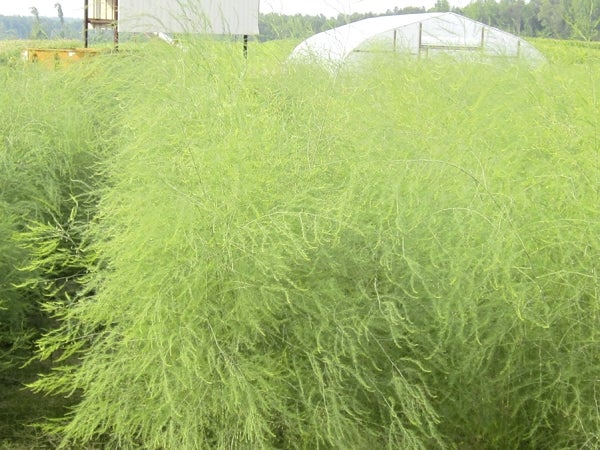Amy-Lynn Albertson: How does your asparagus grow?
Published 12:00 am Friday, February 26, 2016

- Cooperative Extension Asparagus ferns at David Correll's farm in Rowan County.
By Amy-Lynn Albertson
Rowan Cooperative Extension
Fresh asparagus is one of my favorite vegetables. It is also a vegetable that can easily be grown here in the Piedmont in a small space. Asparagus is a perennial plant and if properly cared for should produce for at least 15 years.
Fifteen years is a long time, so you’ll want to make sure your planting bed is prepared correctly before getting started. Any well-drained soil will produce good asparagus.
Our soils are typically heavy clay, so you should condition it with peat moss, leaf mold or straw so spears will emerge straight. Using a raised bed is especially helpful with heavy soils.
Have a soil test made at least six months before planting. Take soil samples 12 inches deep. The soil pH should be 6.0 to 6.7, similar to most vegetable plants.
Choose a site relatively free of perennial broadleaf weeds and nut-grass.
Start building up the organic matter content of the soil at least a year in advance of planting. This can be done by turning under green manure crops, animal manure (cow, chicken or horse — no cats or dogs — straw, peat moss or leaf mold.
Till the soil deeply several times during the year to have it in fine tilth at the time of planting. Use commercial fertilizer in addition to manures. Follow soil test suggestions. If you did not take a soil test, broadcast 3 to 5 pounds of 5-10-10 fertilizer per 100 square feet of bed.
Crowns (roots) should be planted in rows 5 feet apart with the crowns spaced 12 inches apart in the row. The distance between rows can be reduced, but this may shorten the life of the bed. Closer in-row spacing will increase yield.
Use large, well rooted, one-year-old, disease free crowns, purchased from a reliable source. For fresh asparagus on the table you will need around 10 crowns per family member.
Mary Washington (a rust-resistant variety) is a standard variety for most home gardeners. The all-male hybrids Jersey Gem (cercospora leaf spot tolerant) and Jersey Knight produce significantly more yield. They produce no seed, thus, no seedling asparagus, considered weedy, will be produced.
In our area asparagus should be planted in late February to early March. Plant the crowns in a furrow 8 inches deep. Make the furrow wide enough to accommodate the root system of the crowns when fully spread out.
In placing the crowns in the furrow or trench, be sure to have the buds pointing upward. Cover the crowns with 2 inches of soil. As the plants grow, pull soil around the plants gradually until the trench is filled. Try to keep your asparagus bed as weed-free as possible to ensure good quality spear development.
Do not harvest asparagus the first growing season after planting crowns. It can be harvested (cut) for short time (not to exceed two weeks) the second year. Weak plants and small spears result from harvesting too much, too early.
The second year after planting crowns, harvest asparagus from six to eight weeks each year. Weak plants should be harvested for less time. Exercise care in cutting the spears to prevent damage to those spears that have not yet emerged. Cut or snap the spears at ground level. This practice eliminates the possibility of damaging other spears.
Asparagus loses its edibility rapidly after harvest. Fiber develops rapidly after harvest. To maintain asparagus quality, wash and cool asparagus soon after harvest. If the asparagus wilts, it can be made turgid by soaking in cool water.
For more information on asparagus or other horticultural topics, contact Cooperative Extension at 704-216-8970 or on the web at http://rowan.ces.ncsu




